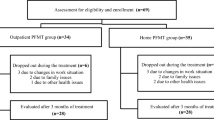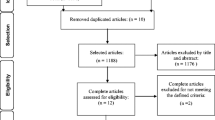Abstract
This study was conducted to evaluate nursing intervention to enhance the efficacy of a home-based pelvic floor muscle exercise (PFME) in treating mixed urinary incontinence among a community-based population. Eighty-eight women with mixed incontinence were recruited for this study and were asked to practice PFME at home as instructed. A registered nurse monitored the study group via telephone checkups twice a week. The Symptoms (LUTS) Questionnaire and a disease-specific questionnaire of impact index were used for repeat measurements before intervention, at 3 and 6 months after PFME. Symptoms such as frequency, nocturia, urge incontinence, and urinary stress incontinence improved significantly in the study group at 6 months. Quality of life with regard to worry about pads/towels leakage and getting wet also improved in the study group at 6 months. Nursing intervention can significantly improve the efficacy of a home-based PFME program in community women with mixed storage symptoms.

Similar content being viewed by others
References
Burgio KL (2002) Influence of behavior modification on overactive bladder. Urology 60(5 suppl 1):72–76
Mouritsen L, Frimodt-Moller C, Moller M (1991) Long-term effect of pelvic floor exercises on female urinary incontinence. Br J Urol 68:32–37
Kegel AH (1948) Progressive resistance exercise in the functional restoration of the perineal muscles. Am J Obstet Gynecol 56:238–248
DeLancey JOL (1988) Structural aspects of the extrinsic continence mechanism. Obstet Gynecol 72:296–301
Payne CK (2000) Behavioral therapy for overactive bladder. Urology 55 (Suppl 5A):3–6
Shafik A, Shafik IA (2003) Overactive bladder inhibition in response to pelvic floor muscle exercises. World J Urol 20(6):374–377
Schnelle JF, Kapur K, Alessi C, Osterweil D, Beck JG, Al-Samarrai NR, Ouslander JG (2003) Does an exercise and incontinence intervention save healthcare costs in a nursing home population? J Am Geriatr Soc 51(2):161–168
Sampselle CM (2003) Behavioral intervention: the first-line treatment for women with urinary incontinence. Curr Urol Rep 4(5):356–361
Urinary Incontinence Guideline Panel (1996) Urinary incontinence in adults: clinical practice guideline. Agency for Health Care Policy and Research (AHCPR), Public Health Service, U.S. Department of Health and Human Services, Rockville, Maryland
Burgio KL, Locher JL, Goode PS, Hardin JM, McDowell BJ, Dombrowski M, Candib D (1998) Behavioral vs drug treatment for urge urinary incontinence in older women. A randomized controlled trial. JAMA 280:1995–2000
Parkkinen A, Karjalainen E, Vartiainen M, Penttinen J (2004) Physiotherapy for female stress urinary incontinence: individual therapy at the outpatient clinic versus home-based pelvic floor training: a 5-year follow-up study. Neurourol Urodyn 23(7):643–648
McDowell BJ, Burgio KL, Dombrowski M, Locher JL, Rodriguez E (1992) An interdisciplinary approach to the assessment and behavioral treatment of urinary incontinence in geriatric outpatients. J Am Geriatr Soc 40:370–374
Chen GD, Lin TL, Hu SW, Chen YC, Lin LY (2003) Prevalence and correlation of urinary incontinence and overactive bladder in Taiwanese women. Neurourol Urodyn 22:109–117
Greenberg RS, Daniels SR, Flanders WD (1996) Medical epidemiology, 2nd edn. Appleton & Lange, Norwalk, CT
Jackson S, Donovan J, Brookes S, Eckford S, Swithinbank L, Abrams P (1996) The Bristol Female Urinary Tract Symptoms Questionnaire: development and psychometric testing. Br J Urol 77:805–812
Black NA, Griffiths J, Pope C (1996) Development of a symptom severity index and a symptom impact index for stress incontinence in women. Neurourol Urodyn 15:630–640
Wells TJ (1990) Pelvic (floor) muscle exercises. J Am Geriatr Soc 38:333–337
Laycock J, Brown J, Cusack C, Green S, Jerwood D, Mann K, McLachlan Z, Schofield A (2001) Pelvic floor re-education for stress incontinence: comparing three methods. Br J Community Nurs 6:230–237
Morkved S, Bo K, Fjortoft T (2002) Effect of adding biofeedback to pelvic floor muscle training to treat urodynamic stress incontience. Obstet Gynecol 100:730–739
Teunisen TA, de Jonge A, van Weel C, Largo-Janssen AL (2004) Treating urinary incontinence in the elderly—conservative therapies that work: a systematic review. J Fam Pract 53(1):25–30
Burgio KL (2004) Behavioral treatment options for urinary incontinence. Gastroenterology 126(1 Suppl 1):S82–S89
Alewijnse D, Metsemakers JFM, Mesters IEPE, van den Borne B (2003) Effectiveness of pelvic floor muscle exercise therapy supplemented with a health education program to promote long-term adherence among women with urinary incontinence. Neurourol Urodyn 22:284–295
Gallo ML, Staskin DR (1997) Cues to action: pelvic floor muscle exercise compliance in women with stress urinary incontinence. Neurourol Urodyn 16:167–177
Nygaard IE, Kreder KJ, Lepic MM, Fountain KA, Rhomberg AT (1996) Efficacy of pelvic floor muscle exercises in women with stress, urge,and mixed urinary incontinence. Am J Obstet Gynecol 174(1 Pt 1):120–125
Chen SY, Lin LY, Lin ST, Chen GD (2000) Compliance to pelvic floor muscle exercise in women with urinary incontinence. J Med Educ 4:484–493
Acknowledgement
We thank The National Science Council in Taiwan (NSC-89-2314-B-040-046) for the grant sponsorship.
Author information
Authors and Affiliations
Corresponding author
Rights and permissions
About this article
Cite this article
Ng, SC., Lin, TL., Chang, SJ. et al. Nursing intervention to enhance efficacy of home practice of pelvic floor muscle exercises in treating mixed urinary incontinence. Int Urogynecol J 19, 637–642 (2008). https://doi.org/10.1007/s00192-007-0492-8
Received:
Accepted:
Published:
Issue Date:
DOI: https://doi.org/10.1007/s00192-007-0492-8




